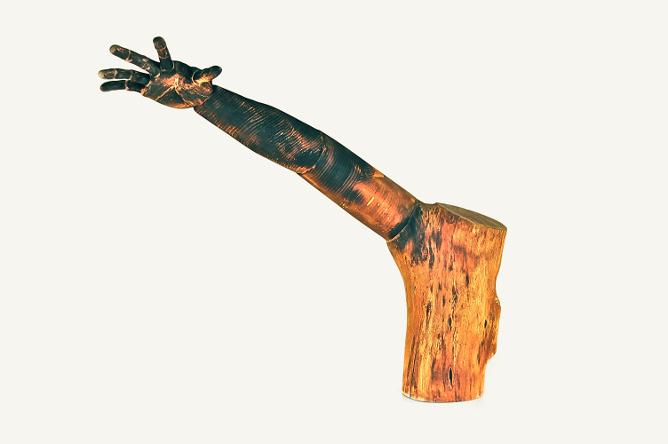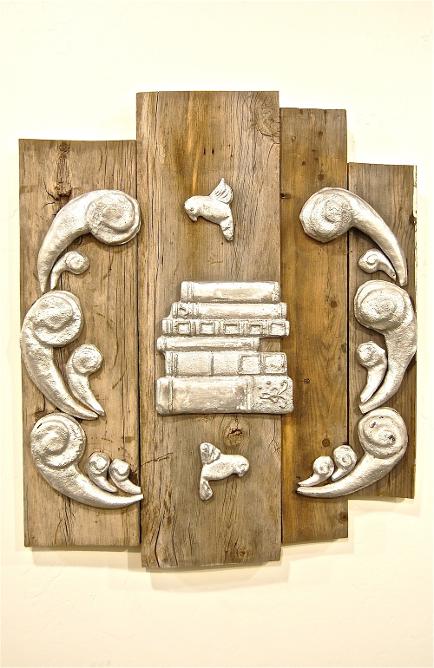Please click images for quick reference portfolio and scroll down for student project descriptions
Image # 1- 4: "Letter Project" Intro to 3D Design 2008
For this project Students explored the creative process as a distilled series of steps that enable effective planning and viable foresight in the making of an object. Craft, in conjunction with the ability to follow directions, were key for this project. Students were limited to specific materials and size requirements and were instructed to select the first or last letter of their name for the letter template. After completing the letter, they then created a form or object of personal significance that started with that letter.
Image # 5: "Wire Project" Intro to 3D Design 2008
For this project students were
instructed to explore line and
mass relationships by constructing a wire replication of a chosen device,
machine, or tool. Through this seemingly simple process students examined not
only the essence of material composition but also what esthetics are gained or
lost in the conversion from an essentially illustrative two dimensional form
into the three-dimensional realm. Students first deconstructed the physical
object through a series of two-dimensional drawings as a means to better
understand the transitions from line to that of the object. After accurately
drawing the form from three separate perspectives they were then responsible
for the objects replication in wire media. As an additional requirement the
wire form had to have a similar mechanical function to that of the original
object and be notably larger in scale. In this example the handcuffs actually
lock. Since the original handcuffs were a children's toy there is no key and
the locking mechanism is released through a simple lever.
Image # 6-9: "Culture Clash Project" Intro to 3D Design 2008
For this assignment students were instructed to select a Pre-1900 culture that they were interested in. Through multiple research sources (Internet, film, literature, museums, anthropologists, and historians) the students were instructed to hone an adept knowledge of their chosen culture, as well as a thorough understanding of that society’s art and artifacts. Based on their research they were instructed to select a uniquely 21st century electronic device and combine it with an object of their pre-1900s culture, hence the term “Culture Clash”.

Image # 10-13: "Wood Project" Beginning Sculpture 2008-2009
For the Beginning Sculpture wood project, students were required to combine two different types of wood (processed and unprocessed or naturally found wood) into a single cohesive piece. These criteria enabled students to use virtually all standardized wood shop equipment while also exploring more traditional hand tool techniques.
Image # 14-19: "Metal Casting Project" Beginning Sculpture 2009-2010
For the bronze-casting project students were to consider the archival quality of the material and create an object they felt would be worthy of both the present and the future. Additional criteria required that the piece have a single mechanical feature.

Image # 20-24: "Crest Project" Ancient Casting Methods Intermediate and Advanced Sculpture 2009
For the Crest
Project students were required to research the symbols and meanings of heraldic
crests in a variety of cultures and devise their own contemporary version to be
cast in recycled aluminum.
Note: Particular to this course, students were taught
early metal casting techniques from ancient Greece, India, and Peru, to create
works out of recycled aluminum salvaged from the City of Tucson. As a summer
course that ran twice, and the economy being of concern, the course was
designed to utilize entirely renewable materials. The budget was derived from
student lab fees that amounted to $200. By pulling resources, and hard work on
behalf of the students and myself, we poured over 500 lbs of aluminum in homemade
greensand, with molding material acquired from a dirt lot. The amount of work
generated from these courses was substantial and exceeded a typical semester’s
production.
In addition to the valuable experiences and results of
the students, the course concluded well under the $200 budget.
Images # 25-27,: “Series on Motion: concrete, rammed earth and ice” Advanced Student Solo Exhibition 2010
12” x 12” x 12” cubes arranged in a square configuration of approximately 31’, Concrete, Rammed Earth, and Ice
More Independent as an advanced student, the
project criteria was largely up to the individual as this was an opportunity to
explore the students specific interests and challenge themselves both
conceptually and physically to create a substantial piece. In this example the student was
investigating the material transitions of three different media: concrete,
rammed earth, and ice. Recognizing natural forces, such as gravity and the
elements, all materials are essentially in a fluid state of motion or transition.
The student selected three different materials with different kinetic traits to
establish this dialog of transition and demonstrate these properties on the
physical plane.








